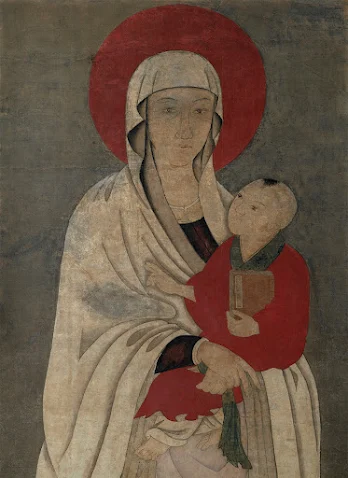When depicting Christ or Our Lady, one always has to consider their individual characteristics (handed down to us by tradition); but at the same time, the artist can always consider modifying their appearance, so that those who are likely to see the painting will identify with Him or her. Here are some paintings by Chinese Christians, the first, from the 14th century and the second from the turn of the last century.
In some respects Christ is the Everyman, the model for all humanity. When He (or indeed Our Lady and the saints) are painted, the image must also participate in a model of humanity that the audience can relate to and try to emulate in their own lives. But at the same time, to be convincing as a person, it must look like a unique individual with individual characteristics. We cannot emulate characteristics that are unique to someone else, but they must be in the artistic portrayal, otherwise the painting will not be convincing. All Christian sacred art is a balance of the general and the particular.If those who are going to see the painting are going to be almost exclusively Chinese, as I am assuming would have been the case with the two paintings above, then it can be a legitimate approach, I would argue, to portray Christ and Our Lady as Chinese. There are many depictions of Christ by Western European artists that show him as Western European for the same reasons.
However, if those who are going to view the painting are used to seeing people from the Middle East, as might be the case in more cosmopolitan societies, such as exist today or was the case in the ancient Roman empire, then it is probably better to aim for a more historically convincing portrayal,
It can be surprising which society chooses the Middle Eastern Christ or Our Lady.
In Russia, it seems, people expected a Middle Eastern complexion. I once had lessons from an icon painter in England who had been at one time a student of the famous Russian iconographer Leonid Ouspensky. Ouspensky was an expatriate living in Paris in the middle of the 20th century, and died there in 1987. She told me to use predominantly the green-brown color (called ‘avana ochre’) with highlights used sparingly in yellow ochre and white specifically because it matched the olive-brown Mediterranean complexion. Ouspensky’s argument rested on the desire for conformity to the Russian tradition, as this is what connected with Russian Orthodox Christians.
 |
| Our Lady of Kazan, by Ouspensky, 20th century |
It seems that an artist has a choice in these matters. The governing principle is that he should aim to maximize his chances of communicating the person of Christ to those who are likely to see his work.




